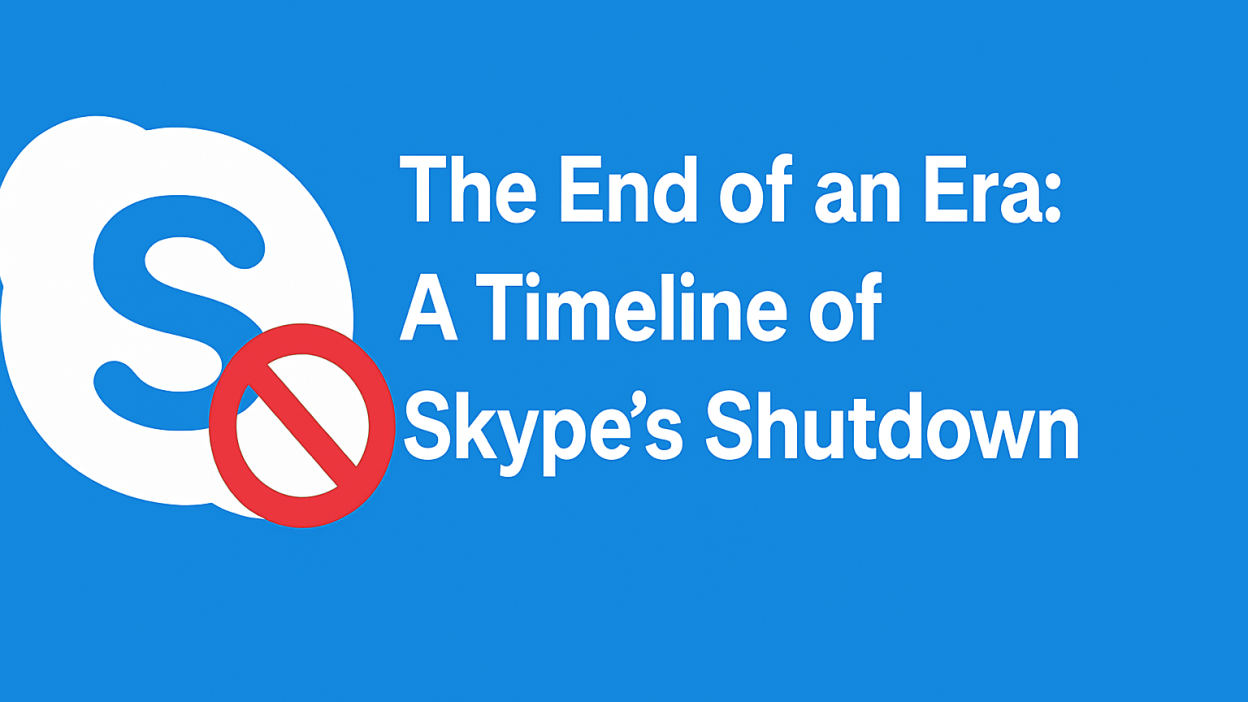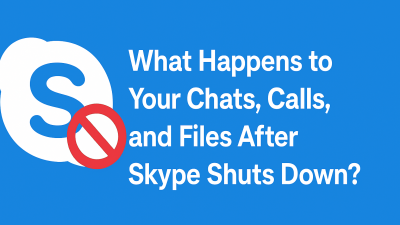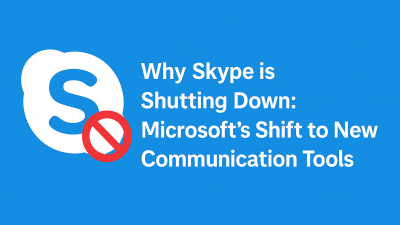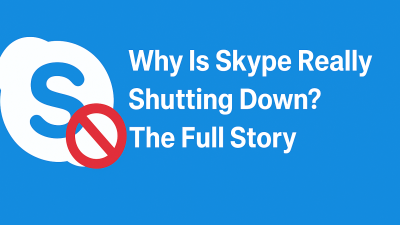Let’s start with this: Skype isn’t just another app being shut down. It was the app that changed how the internet felt.
Before Zoom, before WhatsApp, before Teams, Skype was how we called home from a hostel, interviewed for jobs across borders, taught language lessons, or saw our family during holidays abroad.
So when Microsoft announced it would shut down Skype on May 5, 2025, it didn’t just mark the end of a product. It closed the book on a very specific chapter in digital communication.
This post isn’t about features or comparisons. It’s about the journey the rise, the dominance, the slow fade, and why this shutdown actually matters.
2003–2005: Skype Starts in a Small Apartment, Not a Boardroom
Back in 2003, most people still paid per minute to make long-distance calls. International calling was expensive, clunky, and controlled by big telecoms.
That’s when a team of Estonian and Scandinavian developers launched Skype, a free peer-to-peer internet calling app that let anyone in the world connect by voice.
There was no VC hype. No polished brand campaign. Just an idea that communication should be borderless and free.
Within two years, Skype had millions of users. By 2005, it was so disruptive that eBay bought it for $2.6 billion, hoping to use it for customer-to-seller conversations. That part didn’t quite work, but the platform kept growing.
What made Skype so powerful in the early days:
-
Voice over IP (VoIP) tech that felt almost magical at the time
-
Easy setup and low system requirements
-
Clear audio quality — better than mobile phones for many
-
It worked even on slow connections
Skype wasn’t just a product. It was a feeling, like the internet had finally delivered on its promise of connection.
2006–2011: From Internet Darling to Global Giant
During this time, Skype didn’t just grow — it became part of culture.
Families used it to talk across continents. Startups used it for meetings. English teachers and tutors built entire businesses around it. Soldiers abroad used it to speak to their kids. Long-distance couples built entire routines around nightly Skype calls.
By 2009, Skype had over 100 million monthly active users. That number nearly tripled by 2012.
It wasn’t just early adopters anymore. Skype was mainstream.
Some key milestones during this era:
-
2006: Video calling added, and suddenly, webcams mattered again
-
2007–2009: Integration with TV and mobile starts expanding
-
2011: Microsoft acquires Skype for $8.5 billion, making it their largest-ever acquisition
The future looked locked in. Skype was now the voice of Microsoft’s communication plans. Or at least, that’s what we thought.
2012–2015: Dominant, But Starting to Show Its Age
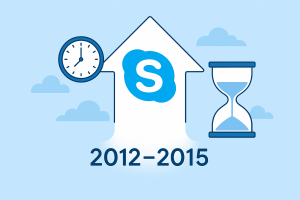
Even after the Microsoft acquisition, Skype still dominated video calls. But a few small cracks started to show, not all at once, and not to everyone, but they were there.
Here’s what started going wrong (and why it mattered later):
A. The mobile shift caught Skype off balance
Skype was built for desktops. The mobile apps felt like adaptations, not original designs. As people began spending more time on phones than laptops, this gap started to hurt.
B. Competitors started innovating faster
-
FaceTime became the default for iPhone users
-
WhatsApp added free voice calling in 2015
-
Slack started dominating internal business comms
-
Google Hangouts offered seamless browser-based video chats
Skype, meanwhile, was starting to feel like the same tool it had always been, just with more updates.
C. User experience started slipping
Updates became less consistent. The UI began to feel outdated. Simple things, like sending a file or managing contacts, weren’t as smooth as users expected.
Skype still had a loyal base, but it was slowly becoming a backup app for many, not their first choice.
2016–2017: The Plateau Before the Pivot
By this point, Skype had over 300 million users worldwide — but its growth had leveled off. It wasn’t crashing, but it wasn’t innovating either.
In response, Microsoft tried a few things:
-
Redesigned the Skype app (with mixed reviews)
-
Began merging Skype for Business with its enterprise tools
-
Quietly started building something new: Microsoft Teams
Launched in 2017, Teams wasn’t introduced as a Skype replacement. It was pitched as a Slack competitor — an internal hub for messaging, files, and meetings.
But Microsoft didn’t just launch Teams and walk away. They poured development resources into it — more than Skype had seen in years.
This wasn’t announced publicly, but it was clear inside the product:
-
Teams was getting new features monthly
-
Skype was getting maintenance updates at best
To the average user, Skype still looked fine. But behind the scenes, the balance was shifting, and Skype was no longer where Microsoft was placing its bets.
2018–2020: Skype Was Still Around — But No Longer Evolving
While Microsoft Teams was quietly expanding its footprint across schools, companies, and remote workspaces, Skype entered a period of slow fade.
It wasn’t gone. It still worked. Millions still used it. But it felt like a product on pause.
Here’s what changed during this time:
-
Skype updates slowed down, with fewer new features
-
Microsoft began shifting internal support and R&D toward Teams
-
Business-focused users were encouraged to move from Skype for Business to Teams
-
The Skype mobile app was redesigned, then redesigned again, with mixed feedback
-
Meanwhile, Teams was becoming the go-to hub for video meetings, chat, file sharing, scheduling, and more
What Skype had built — a simple, direct way to connect — was still valuable. But it was no longer enough for the way people were working and talking in a hybrid, multi-device world.
2020–2022: The Pandemic Accelerates Teams’ Growth
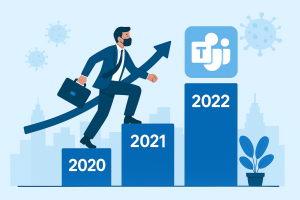
When COVID-19 changed everything in early 2020, video calling suddenly became a daily habit for millions of people, not just a tool for long-distance families or business travelers.
And this is where Teams truly took over.
Teams wasn’t just a “work app” anymore:
-
Students used it for school
-
Nonprofits used it to organize volunteers
-
Families started creating shared group chats
-
Remote teams ran entire projects through it
Skype still had a presence, but it wasn’t where Microsoft was investing. If you wanted:
-
Group video calls
-
Persistent chat threads
-
Document sharing
-
Calendar invites
-
A real digital workspace…
You weren’t using Skype anymore. You were using Teams — whether you meant to or not.
“Skype wasn’t broken. But compared to what Teams had become, it started to feel like yesterday’s tool for yesterday’s world.”
2023–2024: Microsoft Starts Laying the Groundwork
By this point, Skype’s role inside Microsoft was minimal. Teams had become the default communication platform, and now Microsoft needed to help users move over without panic or disruption.
So instead of pulling the plug abruptly, Microsoft began a gradual transition.
Here’s what they did:
A. Launched a fully featured free version of Teams
-
For casual users, not just workplaces
-
Designed to replace Skype in function but offer more flexibility
-
Included chat, video calls, file sharing, and calendar features
-
Allowed users to sign in with existing Skype/Microsoft credentials
B. Added Skype-like features into Teams
-
A dial pad for calling phone numbers (for paid users)
-
Screen sharing, message threads, and one-on-one video calls
-
Skype-style call layout for small group chats
-
Contact migration using the same Microsoft login
C. Quietly began sunsetting Skype’s visibility
-
Skype disappeared from Microsoft product bundles
-
The app stopped receiving major updates
-
Support pages began referring users to Teams
At this point, it was clear: Teams wasn’t just the future — it had become the present.
March 2025: Microsoft Announces the Shutdown
On February 28, 2025, Microsoft made it official:
Skype will be permanently shut down on May 5, 2025.
The announcement was short, direct, and quietly emotional. For many users, it felt like a surprising final step — but in truth, the story had been moving in this direction for years.
Here’s what Microsoft confirmed in that announcement:
-
Skype will no longer be accessible after May 5, 2025
-
Existing users can export their chats, contacts, and files
-
Teams Free will serve as the recommended alternative
-
Users can log in with the same credentials they used for Skype
-
Paid Skype services will be discontinued for new customers
-
During the transition, Skype and Teams users can still message/call each other
They weren’t pushing people into Teams overnight, but they were making the path clear.
May 5, 2025: The Official End of Skype
This is the date Skype finally stops working.
-
The desktop and mobile apps will no longer connect
-
You won’t be able to sign in or make calls
-
Chat history won’t be accessible unless you export it
-
Paid Skype credit will expire, unless refunded before shutdown
-
Support for the product will end completely
For millions of users — especially those who used Skype daily a decade ago — this will be a quiet, strange moment.
It’s not the kind of shutdown that breaks the internet. But for many, it will feel like closing a door that had been open for most of their digital lives.
What Skype Leaves Behind — and Why It Still Matters
This isn’t just about switching to another app.
Skype was more than software. It was a tool that redefined what connection could look like — long before video calls were normal, and long before the idea of “working from anywhere” made it into job listings.
Skype’s legacy includes:
-
Making international calls accessible and affordable
-
Mainstreaming video calling before it was expected
-
Helping build the remote work and freelancing movement
-
Opening the door for platforms like Zoom, Meet, Discord, and Teams
It didn’t fail. It simply reached the end of its path and passed the torch.
Teams may be where Microsoft is focused now, but Skype is what got us here.
“It gave people their first glimpse of what a global internet could really do — not just for work, but for families, friendships, and lives lived apart.”
FAQ Section
1. Why is Skype shutting down in 2025?
Microsoft is retiring Skype to focus fully on Microsoft Teams, its more modern platform for chat, calls, and collaboration.
2. When will Skype stop working completely?
Skype will shut down on May 5, 2025. After that date, the app and service will no longer be accessible or supported.
3. What happens to my Skype account after shutdown?
Your Skype account will be deactivated. Chat history, contacts, and files won’t be accessible unless exported before shutdown.
4. Will Skype users be automatically moved to Microsoft Teams?
No automatic switch happens. You’ll need to sign into Teams with your Microsoft/Skype login and set up from there.
5. Can I still export my Skype chat history and contacts?
Yes. Microsoft offers an export tool to download chat history and files before the shutdown date.

